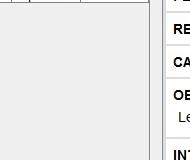Piedrac is a field computer application that allows to record and consult all or almost all the documentation of the archaeological excavation in a single robust and consistent database in the site itself, eliminating the overturning phase and avoiding the problem of dispersion of data.
Information is collected on stratigraphic units, remains, samples, images and spatial coordinates, and the relationships between them. The data is presented through registration cards and tabular lists, which can be sorted and filtered according to their properties and relationships. In turn, the results of these queries can be exported to various formats.
Piedrac Technical characteristics
- Developed in Java SE: compatible with Windows, Linux and MacOS.
- Interfaces through JFC / Swing.
- Code documented through Javadoc.
- Portable: packaged in a single JAR file that requires no installation.
- SQLite database embedded in a single file, manipulable by third-party applications. Information security and consistency through ACID transactions.
- JPG images embedded in the database file.
- Capacity for around a million records and up to 2,000 GB of data.
- Available in Spanish and English. Easily translatable through support for internationalization.

Piedrac operation:
Piedrac has been designed with ease of use and cost minimization in mind. It works on a single low-cost computer (netbook) in the field itself. It does not require any installation or configuration, and the data is stored in a single file without having to have Internet access. This file and the application itself can be easily transferred by mail, USB stick, CD, etc. to other computers.
The images recorded by the cameras, the digitized drawings and the coordinates obtained by means of topographic instruments can be entered on the go or automatically imported at the end of the day.
The information can be consulted through successive filtering and table crossing with great simplicity. For example, the coordinates of the "lithic" type 3 remains that have been photographed twice can be consulted, and the results can be ordered by date of registration.
The result of any query can be exported to the following formats: tables to CSV, tabs to Acrobat PDF or HTML, images to JPG and coordinates to DXF. These are all very popular formats and are handled by many applications. For example, all Microsoft Office or Openoffice applications recognize the CSV format, PDF is an almost universal format and DXF is handled by both AutoCAD and ArcGIS. In this way it is trivial to send to a collaborator, for example, an Excel sheet with the entire level 3 lithic industry and a 3D model of it. There is also a functionality to dump the entire database to Microsoft Access.






















